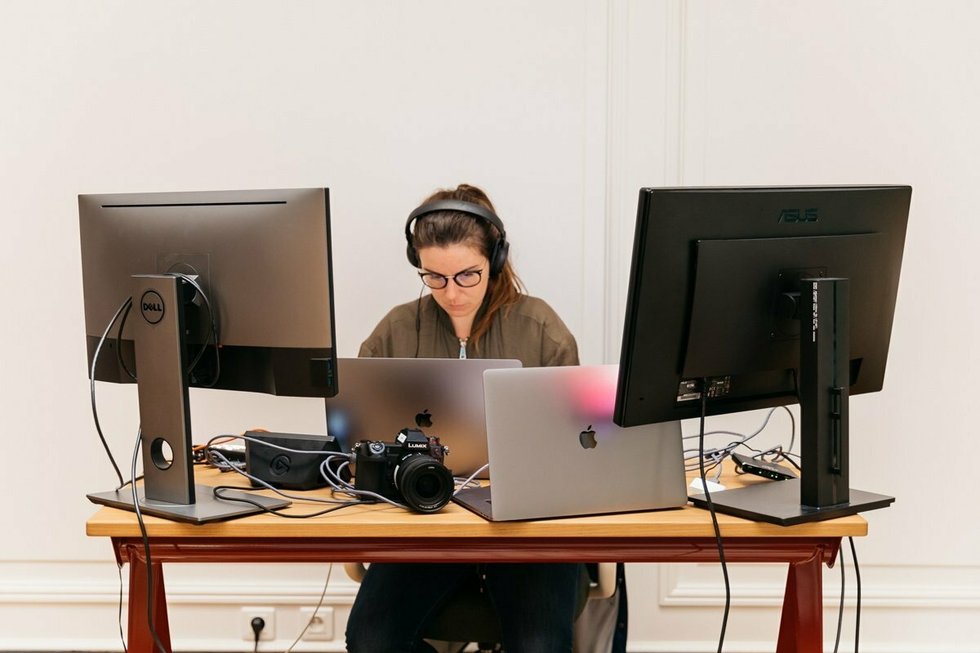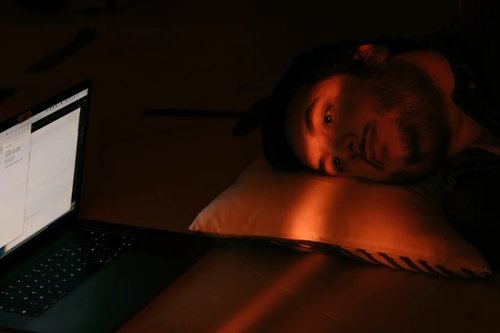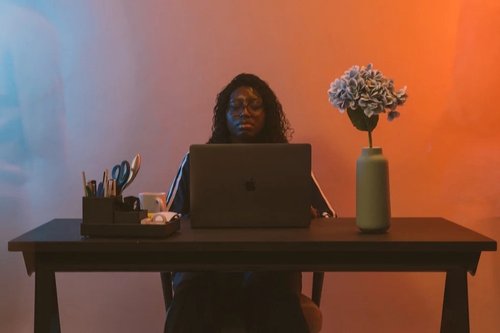Working on a computer: How do you keep it from damaging your health?
Jan 05, 2022
7 mins


Journaliste chez Welcome to the Jungle
Have you noticed colleagues turning up for work with very red eyes or a hunched posture? You can give up playing detective. It’s probably not from spending their time taking illicit substances or even from swimming in an over-chlorinated pool. Like many people who have been working on a computer for eight hours a day, your coworker probably is dealing with a little-known but common condition: computer vision syndrome (CVS), which takes in the winning trio of visual fatigue, musculoskeletal disorders (MSDs) and stress. We shouldn’t be surprised since, according to a study for the American Optometric Association, the average worker spends seven hours a day on a computer either in an office or while working from home. But is it serious, doctor? To better understand this phenomenon, we interviewed an ophthalmologist and an expert in prevention and health innovation.
Let’s get some clarity
If you’ve ever spent a day binge-reading Charles Dickens’ David Copperfield or the latest John Grisham edition, you will have noticed that spending hours with your nose in a book is tiring for your eyes. In theory, computer screens are just as bad as a beloved paperback. “It’s a source of confusion,” says Romain Jaillant, a Paris-based ophthalmologist. “People tend to confuse the fatigue caused by working on a computer with the fatigue caused by looking at something closely while being very focused.”
Generally, the symptoms of this kind of eye fatigue are dry eyes, blurred vision and headaches. But why? “When you look at a screen up close, it forces your lens to adjust,” says Jaillant. “Your eyes are focusing and that gets tiring over time.” The older you get, (which seems somewhat inevitable) the more this phenomenon occurs. “Our ability to focus is much greater in childhood than in adulthood, when this kind of symptom becomes really bothersome,” he says. So if you find that when you’re leaving work you can’t tell the difference between a parking meter and a human being at a distance of 100 feet, that may be because you have been sitting right in front of a computer screen all day long. “If you spend all day looking at a screen that is just 12 inches from your eyes, you’ll probably find that things at a distance look a little blurry in the evening. When your eyes are tired, focusing is not as easy.”
Our eyes are also sometimes so red and dry that the expression “looking into the whites of their eyes” has no meaning. That’s not so surprising, given the fact that even though we blink 15-20 times a minute on average, that natural reflex drops to six blinks when in front of a computer screen. However, “blinking allows you to regenerate your tear film. When this film doesn’t get renewed, your eyes sting,” says Jaillant. But don’t worry, making a few adjustments will help you get your bright eyes back.
Four solutions to improve your eye comfort at work
1. Have a perfect set-up
“Ideally, you should place your computer as far away from your eyes as possible. That way, you reduce the fatigue associated with trying to focus. Personally, I have a large screen at a fairly long distance from my eyes and I use a large typeface. Most problems are eased by doing this,” says the ophthalmologist. Specifically, this means the top of your screen should be in line with your eyes. Depending on the size of your screen, it should be between about 20 and 27 inches away from your eyes.
2. Choose the right brightness level
Having the right lighting is the second recommendation for avoiding any discomfort from working on a computer. “Working in the dark puts your eyes in a state of mydriasis, which means that the pupils dilate in order to absorb light. Compensating for this by working with your screen brightness at its maximum accentuates this effect,” he says. Ideally, you should minimize the contrast between the brightness of your screen and the brightness of the room. Placing your computer screen perpendicular to a window will help you to make use of the natural light from outside while avoiding any glare.
3. Do eye gymnastics
“You should take breaks every two hours and look into the distance to give your eyes some rest. You should actively blink your eyes so they don’t get irritated. You can use eye drops for any persistent discomfort too,” he says. The 20-20-20 rule is a good way to remember these recommendations: every 20 minutes, look at something 20 feet away for 20 seconds. You could wink at a passing pigeon outside the window or ask a colleague to give you your eye drops, Clockwork Orange-style. (Actually, best do that one yourself.)
4. Wear computer glasses
Finally, you can seek out the advice of an ophthalmologist to reduce eye strain and get a prescription for computer glasses. “Computer glasses will take over some of the focusing which will reduce the strain on the eyes.” What about the blue light that’s often talked about? Does it affect your vision or cause additional eye fatigue? Is it dangerous in the long term? “It has not been scientifically proven that the risk of having AMD (age-related macular degeneration) or cataracts is increased by spending many years working on a screen. Each person has their own criteria when it comes to precautions. Having said that, nti-blue light filters reduce the overall amount of light that reaches the eyes, so that does play a role in reducing fatigue,” says the ophthalmologist.
Computers and caring for the body and mind
It’s not just your eyes that are affected by working on a screen. Stuck in the same position for hours, your body can suffer too. This can lead to musculoskeletal disorders (MSDs), particularly those conditions affecting the parts of the body around the joints. The back, and more generally, the upper parts of the body (wrists, shoulders, elbows) are most frequently affected. Repetitive gestures and lack of movement are the main causes of muscular tension, which causes MSDs. But how can you avoid doing damage to your body?
Also with physical fatigue, there comes mental fatigue. You shouldn’t forget that working on a screen creates other problems such as “increased stress,” says Cecile Rivoiron, president and founder of Ekipoz, a company that offers innovative solutions to promote well-being and health in the workplace. On top of the risk of addiction to your device, “exposure to a screen, or even to several screens, alters your concentration and ultimately your efficiency while you work,” she says. Hence that feeling of overload that sometimes awaits you after a day of tapping away at your keyboard. But don’t worry, here are some good habits that can reduce the side effects of digital work.
How to maintain a healthy mind and body
1. Have an ergonomic workstation and good posture
“Long exposure to screens can lead to musculoskeletal risks due to poor posture,” says Rivoiron. This means that adapting your work environment and posture is essential. There are guidelines you can follow when setting up your workstation. For example, you should use a tilted keyboard and make sure that the mouse is placed so that you don’t have to stretch your shoulder or extend your wrist. The must-have when it comes to this is an ergonomic chair and an adjustable desk, one where you can sit or stand. Otherwise, you can make do with a small cushion, wedged behind the small of your back. “In order for your body to have as little tension as possible, it’s important to avoid adopting a position that involves straining your neck or your arms. You should avoid muscular tension at all costs.”
2. Keep moving
It’s not easy to move around when you work at a desk in front of a screen. However, getting up and not always sitting at your desk is essential if you want to avoid the risks related to a sedentary lifestyle. “After three hours in a seated position, there’s a negative impact on your health,” says Rivoiron. Most people spend an average of eight hours at work and about six hours of their time sitting down. While she knows factors vary greatly from one job to another, the specialist suggests “making phone calls while walking, or walking up and down the stairs during the day”. These are good habits to create so you can limit the dangers associated with a sedentary lifestyle. On top of that, moving around helps reduce the stress caused by screens. “By leaving your computer to go for a walk, you will break away from your screen, which will be beneficial at every level, physically and mentally.”
3. Take breaks
Rivoiron recommends taking regular breaks. “Five minutes every hour when you’re on your computer, or 15 minutes every two hours, if the activity isn’t as intense,” she says. “It’s known that concentration decreases substantially every 25 minutes, give or take, which is why it’s necessary to take regular breaks. These breaks will be very beneficial for your immediate well-being, as well as for your long-term health.” You can turn these pauses into rituals while you work on your breathing, says the specialist. The idea behind it? Becoming aware of your break, for example, by simply, “doing a cycle of three breaths in and out, as slowly as possible.” Take a break by getting a coffee at the shop around the corner, and don’t hesitate to take the stairs. Your body will thank you later.
4. Avoid screens whenever possible
Remember that not everything has to be done online in our daily lives, says Rivoiron. “It’s possible to replace some video call meetings with meetings over the phone. It’s less tiring and it leaves you more mobile,” she says. This practice is all the more important to counteract “Zoom fatigue”, the weariness caused by having to attend endless videoconferences that’ve been happening since working remotely has gotten more widespread.
5. Stretch
Stretching is also a good idea if you want to avoid the pain associated with screen work. Happily, you can stretch just about every part of your body. Do you have wrist pain after a day of typing? Try doing some rotational exercises like the ones you did in PE class when you were about to try doing a round-off. You can also pull your shoulders up towards your ears as if shrugging to say “I dunno.” If you hold this position for three to five seconds, it can reduce stiffness in your neck and shoulders. “Muscle mobility exercises can be done at any time of the day,” says Rivoiron.
Let’s not forget that computers are tools. They may be essential to our professional and personal lives, but it is up to us to make sure we use them wisely. Do you blame a shovel if you get blisters on your hands from using one? In the digital age, working off-screen is nothing more than a dream for any office-based worker. So guarding against the harmful effects of screens is essential if you want to protect the health of your eyes, your body and your mind.
Translated by Kalin Linsberg
Photo: Welcome to the Jungle
Follow Welcome to the Jungle on Facebook on LinkedIn and on Instagram and subscribe to our newsletter to get our latest articles every day!

More inspiration: Physical health

Navigating your career while managing chronic illness
Struggling to juggle work and chronic illness? Learn how to create a supportive career path and find solutions.
Dec 24, 2024

The best equipment to help you get exercise without leaving your desk
A sedentary lifestyle can lead to serious health problems. So, how can you stay fit while still at your desk?
Nov 09, 2023

Glued to your desk all day? Try these discreet exercises
Laptop-based work can mean freedom and comfort, but a sedentary lifestyle also brings a host of health risks...
Oct 18, 2023

How the world of work is getting better for veterinarians
Though typically not considered a dangerous profession, veterinary services rank among the highest industries for non-fatal injuries
Oct 04, 2023

The dynamic benefits of walking meetings
As our jobs become more flexible, workers are finding new ways to improve their mental and physical health
Oct 03, 2023
The newsletter that does the job
Want to keep up with the latest articles? Twice a week you can receive stories, jobs, and tips in your inbox.

Looking for your next job?
Over 200,000 people have found a job with Welcome to the Jungle.
Explore jobs